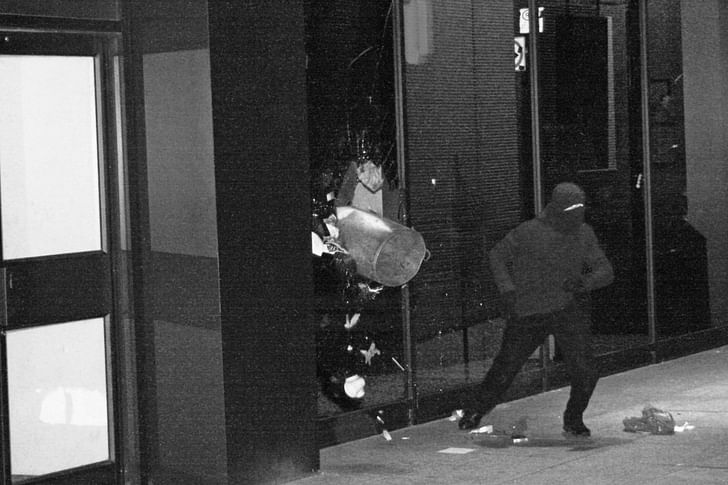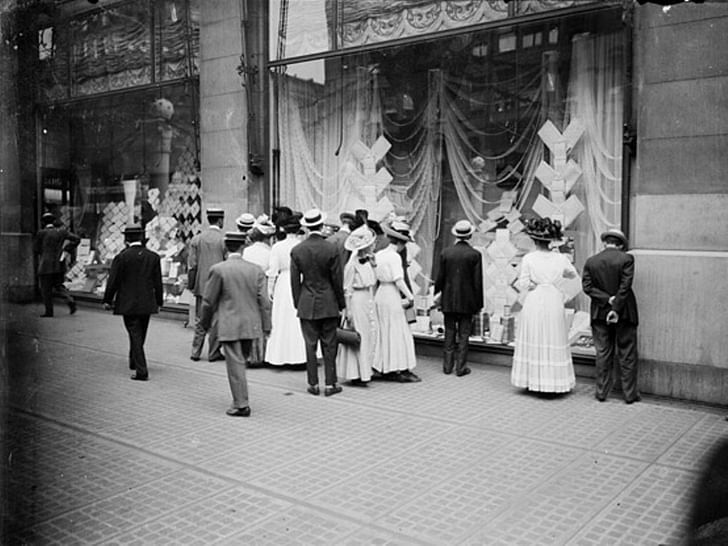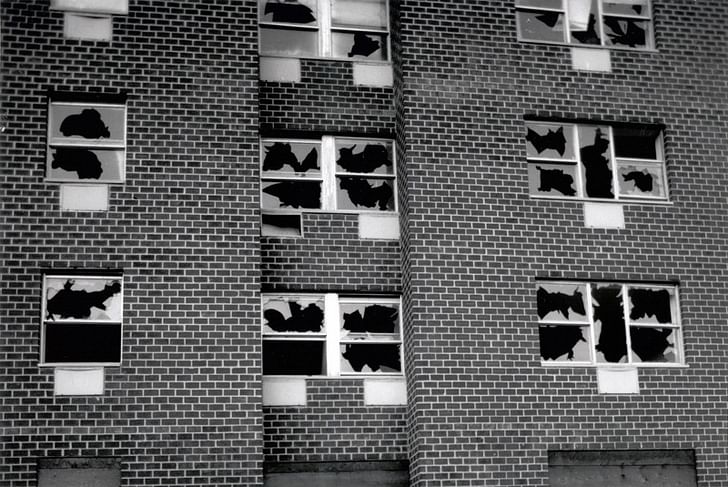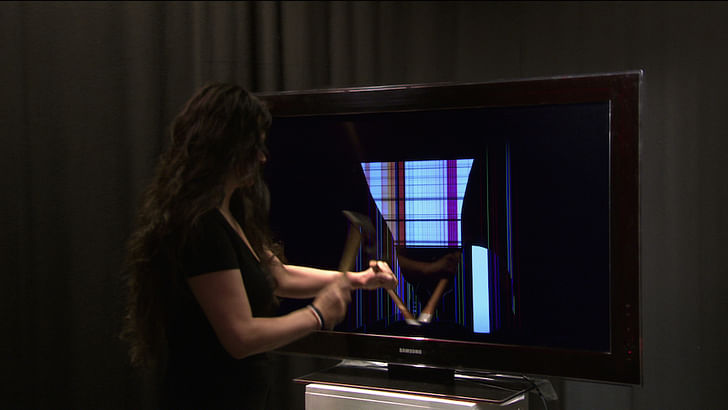

Throughout modern history, the shattered transparent envelope has, in various ways, indexed social crises wherein revolution leads to the dismantling of the crystalline boundaries between public and private property. From the Watts Rebellion, WTO, and G8 protests to the 2011 London Riots, Black Lives Matter protests, and the inauguration of Donald J. Trump, the shattered glass window repeatedly proves to be a site of counter-identification with systems of oppression under late capitalism. Learning from these events, how might we differently consider the act of window-breaking beyond the conventional understandings of protest and felony, and instead, reframe it as an intersubjective form of resistance and disavowal?
Glass is arguably one of the most abundant materials found within the global city. A surface that conditions and mediates vision in multiple forms, from the transparent windows of corporate architecture to the hand-held touch-screen devices of contemporary digital infrastructure, glass permeates daily life as both a material to be looked through and looked at directly. Much consideration has been given to the transparent function of glass as an apparatus of surveillance akin to, and alongside, technologies that allow for the tracking and monitoring of our every movement through the urban landscape. Less considered, perhaps, is the way in which glass plays a key perceptual role in shaping desire and constituting our social reality. While the global city is continually reproduced under an ever-regenerating transparent skin, most notably with the proliferation of shimmering luxury curtain-walls and storefront lined streets, these surfaces in fact create a spatial condition in which we are repeatedly confronted by our own reflections. Perhaps the most surveilled landscape under such conditions of urban scopophilia is in fact the self—the mirror image that confronts us in our digital screens and storefront windows. What role might such conditions of reflectivity play during times of extreme political unrest, when the glass storefront window serves as one of the first, and most visible sites of protest? Breaking the glass windows of urban architecture signals a certain demonstrative rejection of the globalized built environment. As an act of resistance and performance of dissent, the smashing of windows both literally and symbolically shatters the seemingly transparent (yet deceptively opaque) division of public and privatized space, opening access to the interior of private property from the last vestiges of the commons – the city street. How might the breaking of glass point towards an aggressive object-relation that crystalizes the often-repressed forms of alienation and exclusion normalized under late capitalism? Moving past the assumed correlations between riot, vandalism, and looting, how might a psychoanalytic reading of the inter-subjective relationship between subject and object—in this case, using images of window and window-breaker—be useful in rethinking this recurrent condition of dissent?Breaking the glass windows of urban architecture signals a certain demonstrative rejection of the globalized built environment.
The fallacy of transparency has long plagued modern architectural discourse. Perhaps most significantly theorized by Colin Rowe & Robert Slutzky, “transparency may be an inherent quality of substance, as in a glass curtain wall; or it may be an inherent quality of organization.”¹ The tension between transparency’s substantive and organizational qualities is perhaps what makes the display window, out of so many transparent typologies, such an intriguing architecture for study. It is a spatial condition that points to the many ways in which vision itself is conditioned by capitalist ideology. Contingent upon literal transparency, it is an architecture that is not only instrumental in the construction of desire, but one that perhaps carries a disciplining function as well. For instance, since the early 1900s, display windows were used to dazzle, educate, and interpellate the public, displaying objects abstracted from the very labor that produced them. With the development of plate glass production and department stores, window-dressing emerged as a Modern artistic profession and brought with it new forms of spectacle.² The Deutscher Werkbund, who collectively generated a significant amount of thought on the significance and potential of this form of commercial architecture, saw “the shop window [as] perhaps the most practical means of educating both the retailer and the public at large.”³ Indeed the display window educated the public in the ways of taste by encouraging conspicuous consumption, but in this way it was also an architecture that produced a subject. As architectural historian and theorist Lauren Kogod has observed, “[If] craftsmen had once created tools and wares to satisfy specific needs, under the reign of Großkapital it was consumers that were produced—fashioned through their longing gazes—to insure the continuous circulation of money.”⁴ If we consider the ways in which these spaces, from London to Chicago, were instrumental in promoting a capitalist ethos and new forms of desire, perhaps we might also argue that this was an architecture that—not unlike Jeremy Bentham’s panopticon—became embodied.


Yet, more than just an invisible barrier, glass is a screen for projection, a material that always indexes its surrounding environment. Following architectural theorist Anthony Vidler, literal transparency “is notoriously difficult to attain” and “quickly turns into reflectivity (its reversal).”⁵ The artist Dan Graham has similarly observed that glass used in display windows “isolates the consumer from the product at the same time as it superimposes the mirror-reflection of [their] own image onto the goods displayed.” Recognizing this perceptual condition as producing both alienating and desirous effects, Graham goes on to observe that “under capitalism, just as the ego is confused with the body image in the mirror, so that ego is confused with the commodity. The individual is made to identify [themself] with the image of the commodity [so that the] commodity object is a substitute fetish for [their] lack.”⁶ Certainly Jacques Lacan, who observed the formation of the I in relation to one’s reflection “as an identification in the full sense analysis gives to the term”⁷ (or what he called ‘The Mirror Stage’), is an essential precedent for both Vidler and Graham’s observations. Yet perhaps it is through the work of object relations theorist and psychoanalyst Melanie Klein that we might rethink the very object relations at play between the public and its collective reflection in the storefront window. In a brief passage in her seminal 1946 essay “Notes on Some Schizoid Mechanisms”, Klein introduces the concept of projective identification. Following Freud, Klein identified projection as a defense against anxiety, yet developed this concept to include a process in which “bad parts of the self”⁸ are split off and redirected at an external object, resulting in “an identification of an object with the hated parts of the self.” Indeed, for Klein there is an inherent narcissism in this process of expelling unwanted parts of the self into another person. Yet, while Klein associated this process largely with psychotic disorders, and in particular, infants, she observed that not only bad parts of the self were expelled but good parts as well, which becomes an essential process in developing healthy relationships and ego integration. If we are to extend Klein’s model on a broader scale to include what might be called social object relations, how might we interpret images of window breaking as a collective process of projective identification? If we recall Vidler’s observation of the way in which literal transparency is in fact, reflective, what are we to make of the group subject’s reflection in the constructed scene of the window frame? Through the shattering of the window, it is perhaps not only the resistance to capitalist ideology and structural violence that is rejected, but the ways in which we are interpellated by this ideology, by the way in which it is internalized within us. Indeed, in reviewing images of protests and riots, it is clear that the social does not positively identify with its image reflected in the glass window. Following Klein, perhaps we might argue that it is the disavowal and splitting off of the “bad parts of the self”⁹ that are collectively unwanted as a result of bourgeois hegemony.the social does not positively identify with its image reflected in the glass window
Another curious psychological feature of transparency, as an “inherent quality of organization”¹⁰ (Rowe), is the way large plate glass might uphold civility and social norms. Surely transparency, in this way, carries a unique sort of regulating function and becomes the “very epitome of social morality”¹¹ (Vidler). That large exposed sheets of glass often remain unbroken until periods of dissent perhaps raises questions about forms of trust, or as sociologist Pierre Bourdieu termed this, a habitus – “the social made body”.¹² This form of trust is perhaps telling when considering the types of neighborhoods in which large plate glass first appears. Yet civility may become weaponized through forms of policing as well. For instance, in 1982, George L. Kelling and James Q. Wilson published “Broken Windows” in The Atlantic, a sort of neoconservative treatise advocating for wider forms of policing and social surveillance as a means of ensuring public safety. Through an implied racist and abelist logic, Kelling and Wilson use the broken window as a signifier for larger questions of social decay and fear. They claim “[social] psychologists and police officers tend to agree that if a window in a building is broken and is left unrepaired, all the rest of the windows will soon be broken.” They go on to assert that “[this] is as true in nice neighborhoods as in rundown ones. Window-breaking does not necessarily occur on a large scale because some areas are inhabited by determined window-breakers whereas others are populated by window-lovers; rather, one unrepaired broken window is a signal that no one cares, and so breaking more windows costs nothing. (It has always been fun.)”¹³ Kelling and Wilson exemplify a neoliberal ethos of self-sufficiency and personal responsibility without accounting for the imbedded structural violence of capitalism. Instead, they cite a fear of “disorderly people” (evidently, non-“window-lovers”) and pathologize “disreputable or obstreperous or unpredictable people” such as “panhandlers, drunks, addicts, rowdy teenagers, prostitutes, loiterers, the mentally disturbed”¹⁴ for making public space less safe. As if the majority of these bodies are not the very bodies most victimized by institutionalized racism and abelism, not to mention the very bodies excluded from participating in a public the authors wish to keep safe. Kelling and Wilson fear a kind of imaginary subject that embraces the broken window and its supposed contagious social effects.

Yet, in light of moments of unrest such as the Watts Riots, WTO and G8 protests, the 2011 London Riots, Black Lives Matter protests, and the inauguration of Donald J. Trump, and countless others, the broken window repeatedly proves to be a site of counter-identification with systems of oppression under late capitalism. Learning from these events, how might we differently consider the act of window breaking beyond the conventional understandings of protest, and instead, reframe it as an intersubjective form of resistance and disavowal? While there is certainly a danger in abstracting these events from their historical and political specificities, generally speaking, protest, while at times physically destructive, is also largely socially constructive as a constitutive form of aggression. The filmmaker Hito Steyerl has noted the complex “dynamic[s] of desire and refusal, attraction and repulsion, the contradiction and the convergence of different elements”¹⁵ at play during these moments of protest. Steyerl herself has performed a similar sort of sentiment in her short film STRIKE (2010) in which she confronts a large-screen Samsung monitor with a hammer and chisel. how might we differently consider the act of window breaking beyond the conventional understandings of protest?Revealing the screen as an illusionistic window in itself, in a swift and almost effortless gesture, Steyerl shatters the liquid crystal display, and the apparatus’ ability to display representation. Calling representation into question one-step further, the film is shown on a similar black LCD monitor that creates a sort of mise en abyme, and invites the viewer to enact a similar kind of resistance. In Get Rid of Yourself (2003), an ‘anti-documentary’ by the art collective Bernadette Corporation, the complex montage of contrasting forces Steyerl describes is depicted most acutely through a non-hierarchical shared experience of the 2001 Genoa Riots. Throughout the film, the actor Chloë Sevigny practices embodying a script in an almost Brechtian fashion; pacing back and forth in a kitchen she repeats, “I gathered stones and put them in my pockets. But I don’t know, metal poles aren’t that bad for bashing in a window.” Through an assemblage of footage, the film poses a question about the kind of image the social sees reflected in the window. Depicting political activism epitomized by the ‘black bloc’ movement (groups known for wearing all-black apparel as a means of concealing identity), the film presents an assemblage score for alternative forms of sociality through collectivized resistance. Yet what is curious about a ‘black bloc’ is perhaps the uniform, non-individualized appearance the collective assumes, a form theorist Emily Apter might call ‘ethical militance’ – a “political collectivity that seek[s] to supplant bourgeois individualism with a new notion of the group or ontological set.”¹⁶ Indeed, following Apter, we might also consider this collective disavowal as an urgent act of striving for a better model for collectivity, a different constitution of the ‘self’. Interestingly, however, it is the state, that through its criminalization of window breaking interpellates the subject as an individual and separates them from the group.

It seems worth noting, however, that what is suggested here is not an advocacy for forms of violence, but rather a different way of considering its intersubjective impulses as part of a collective struggle. Indeed, as Apter herself suggests, "[t]he point is not to hold radical thought accountable for allowing ethical militance to free fall into parliamentary terror (misrecognizing its own camouflage, as it were) but rather to see how ethical militance might be preserved, kept at a remove from terrorism even when it comes mimetically close to militarization." In light of rising forms of global neoconservativism that seek to uphold hegemonic forms of group subjectivity, ethical militance seems increasingly urgent. Moreover, perhaps through the work of Melanie Klein we might rethink the social object relations at play during times of political unrest. If Klein saw projective identification and the “splitting off [of] parts of the self” as an act of “vital importance for normal development”¹⁷, then the breaking of windows not only signals opposition, but perhaps also an “attempt to foment an anti-bourgeois ego ideal within the radical collective”¹⁸, an impassioned attempt to create larger forms of social reparation through an expulsive act, and a desire to ‘get rid of the self’.
No Comments
Block this user
Are you sure you want to block this user and hide all related comments throughout the site?
Archinect
This is your first comment on Archinect. Your comment will be visible once approved.